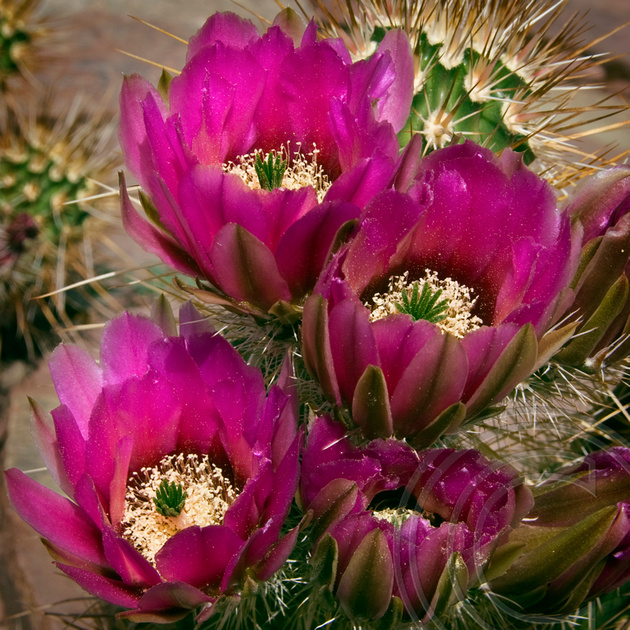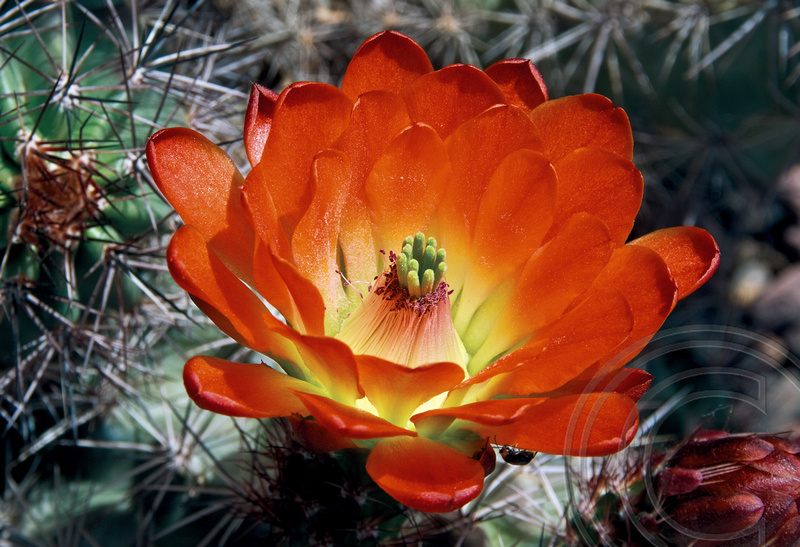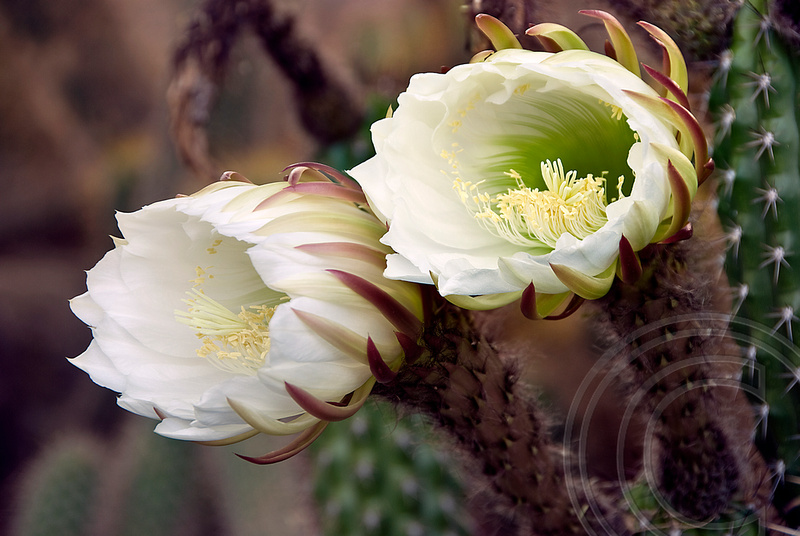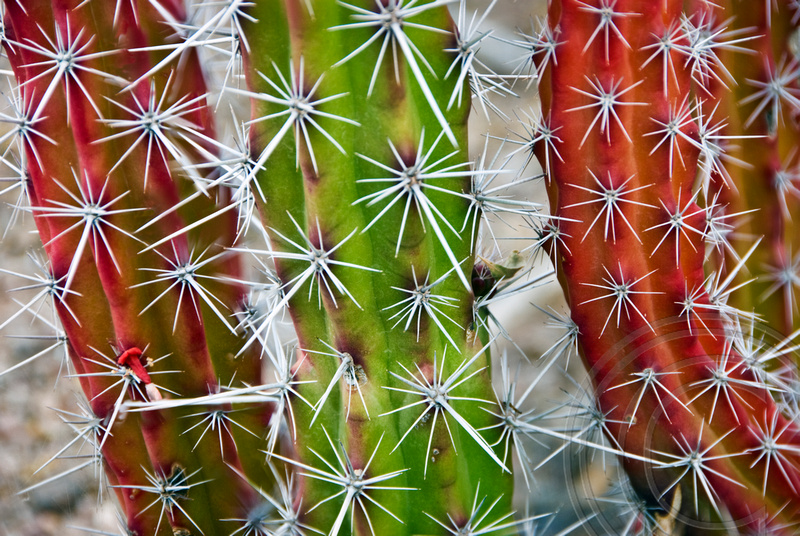Options
Desert Flowers
I thought I would share a few desert flower shots from this past spring here in Arizona. This is my first attempt at flower closeups, so would appreciate suggestions. These are all multiple shots taken at different focus points, blended together to broaden the DOF.
1.

2.

3.

4.

5.

1.

2.

3.

4.

5.

My stuff:
http://davedilli.zenfolio.com/
http://davedilli.zenfolio.com/
0
Comments
http://danielplumer.com/
Facebook Fan Page
https://www.flickr.com/people/scardenphoto/
As is the work at your zenfolio site. Very nice stuff
I need to work with this focus blend technique if results like these are possible.
http://dougsphotos.smugmug.com/
I have been reading up on the multiple focus exposures technique for macro, but have got stuck on just how the focus is altered from one shot to another. In everything I have read, it's blithely said to change the focus for each shot in the sequence. But exactly how is mostly passed over. Apparently you have to change the focus by exactly the same amount through the sequence of shots. Well, apart from using rails and other gadgets, how do you do that? And what exactly do you change when you change the focus? If you shift the camera forward or back the sizes and positions of the things in the frame are going to change, and even new content will be brought into the frame. Do you just turn the focus ring manually a little ways at a time while keeping everything else unchanged?
So, if you could give us a little tutorial on your obviously very successful technique I for one would be very appreciative!
Neil
http://www.behance.net/brosepix
Thanks everyone for the comments. I appreciate you taking the time to give me your perspective.
Neil,<?xml:namespace prefix = o ns = "urn:schemas-microsoft-com:office:office" /><o:p></o:p>
<o:p></o:p>
My workflow is really straightforward.<o:p></o:p>
<o:p></o:p>
For the focus bracketing, I turn off autofocus, autoexposure and autoWB. Then, after setting up the camera /tripod, manually focus to the farthest point that I want to be in focus and use a remote to trigger the shutter. I then select a closer focus point and trigger the shutter, and continue incrementally selecting closer focus points and triggering the shutter. For the process I use, all I am doing is making sure each portion of the photo that I want to be in focus is in focus in at least one exposure – it does not matter if the different focus points are the same distance apart . You have to be really careful there is no movement or wind or the blending will be a mess later. That is about it for the focus bracketing.<o:p></o:p>
<o:p></o:p>
I then mask and blend in PS.
I know there are a number of ways to do that. For me I bring all shots into ACR and make sure I synchronize any edits so all shots are consistent, and then bring all into PS.
Once in PS, create one file that has each exposure on a different layer, top layer with the farthest focus point, and then all subsequent layers are in order as the focus point moves closer. Starting at the top layer I mask off those portions of the layer that are not in focus. I then move to the second layer and do the same – and repeat the process to the end. This is really painstaking because you have to go back and forth between layers to make sure you are revealing the sharpest portion of the image, and masking the other layers. It is also difficult if there was any movement.<o:p></o:p>
<o:p></o:p>
That is about it for what I do - you can see mine is a "brute force" manual process.
<o:p></o:p>
I have a friend who uses the software below - helicon focus - to merge the multiple images – without having to do the manual blending. I have not tried it, but he gets great results.<o:p></o:p>
<o:p></o:p>
http://www.heliconsoft.com/heliconfocus.html <o:p></o:p>
<o:p></o:p>
<o:p></o:p>
I hope this is helpful – let me know if this does not make sense.<o:p></o:p>
<o:p></o:p>
Dave <o:p></o:p>
<o:p></o:p>
http://davedilli.zenfolio.com/
Thanks again for the great help!
Neil
http://www.behance.net/brosepix
http://danielplumer.com/
Facebook Fan Page
Thanks for the software suggestions. Funny - after I wrote that post I thought I really need to check out some of the software to make that blending job easier! Now I have some direction.
Dave
http://davedilli.zenfolio.com/
I checked out these guys, and they apparently, through their licenses, want to retain some monetary rights over photographs you use their software with, unless you pay them $300, and again each time a major version is released! Seems a bit out of touch with reality to me. How, for example, could you separate out the value of editing in any photo contributed by your RAW converter, LR, PS, their SW, etc, etc - and your own genius?!
Neil
http://www.behance.net/brosepix
Neil
http://www.behance.net/brosepix
Caution is always a good idea whenever executing a program downloaded from the internet -- particularly so when an antivirus program raises an alert. I'm still trying to nail down exactly which files and versions are involved, but apparently Lavasoft AdAware is triggering a false alarm on something in one of our installers. This is the first one of these we've ever gotten, which is actually pretty surprising since we've been distributing a string of updated installers for about 14 months now.
Regarding the other concerns raised by NeilL, all I can say is a) I'm a software developer, not a website designer, b) his email to support@zerenesystems.com was answered 49 minutes after he sent it, and c) read the license agreement yourself. It's not complicated and there's a quick summary: "Professional Edition is for people who make money using Zerene Stacker. You need the Professional Edition to use Zerene Stacker in support of a corporation or government activity, or to make images for sale. Personal Edition is for hobbyists and their families. It’s for people who use Zerene Stacker for satisfaction, not money."
dlplumer, thanks for the reference to Zerene Stacker. Most users of Zerene Stacker are working at higher magnification (1:1 or higher). There is lots of that work discussed in the forums at http://www.photomacrography.net. The tradeoffs between various packages are a little different for lower magnification work like the beautiful flowers shown here by daveman. Many of the issues are discussed in a review by Michael Erlewine posted at NikonGear. Further discussion can be found in his online book "The Art of Focus Stacking".
I hope this is helpful. It's nice to make your acquaintance!
Rik Littlefield
--Rik
Thanks for this, Rik.
After seeing your posts here, and receiving your emails, and after further research about Zerene, I am reassured about your bona fides. I D/L the trial version and used it to do my first focus stack. I liked the results, though my shot is amateurish (I haven't done macro before this). I posted it to the Holy Macro forum.
Neil
http://www.behance.net/brosepix
Your Redbells over in Holy Macro look great, could be the best first stack I've ever seen.
--Rik
Yes, Zerene is classy - smooth, efficient, fast, effective. Doesn't mess with IQ, and is conservative in image treatment. Very few artifacts. I like how it handles 16 bit tiff, and color spaces such as ProPhotoRGB, both were the case with Redbells. The retouching feature is a star. I did miss not being able to work at 100%. There was a bit of a squabble on first opening the app over memory allocation, and there was an error message concerning a java engine not loading, something to that effect, but I ignored it and it apparently sorted itself out. However, it did seem to suggest that there could be too low a limit to file size. I have 2GB RAM, and Zerene was telling me I could have a max file size of only 14MB, which would be totally impractical for most photogs with high MP cameras and consumer computing resources.
Neil
http://www.behance.net/brosepix
14 megapixels implies a memory allocation of something like 1060 MB (see the bottom field at Options > Preferences > Memory Usage). That value is unusually low. Normally the 32-bit version of Zerene Stacker can get 1500 MB or a little more, which allows processing of images up to 20 or 21 megapixels.
Unfortunately, some 32-bit Windows computers have software installed that prevents Zerene Stacker from getting the normal amount of memory. In that case maximum image size drops in proportion to the amount of memory that it can get. The symptoms you're having suggest that you have the bad fortune to be using one of those computers. We know of one third party program that causes this problem -- the ZoneAlarm Toolbar as described on the Known Issues page. In that case there is an easy workaround. In other cases, identifying and fixing the problem can be challenging. We have a diagnostic program that can help nail down the problem, but using it can get pretty arcane. Let us know if you're interested in pursuing that effort.
The full power of Zerene Stacker kicks in when it is installed on a 64-bit operating system. In that case, there are no artificial limits on memory so ZS can use whatever you've got. Even on a 4 GB system, with 3 GB allocated to ZS, that translates into 41 megapixels. Make it 6 GB physical with 5 GB allocated, and you've got 68 megapixels.
A few years ago, a 64-bit 4 GB computer would have been leading edge. Today, that capability can be purchased from Dell as a small desktop box for under $330. (Add another $60 to go to 6 GB.) Personally, I'd prefer something faster than that, but the point is that modern consumer computing resources work fine. It's certainly true that older smaller machines impose restrictions, in which case ZS degrades gracefully by downsizing images on the fly as you've observed.
The diagnostic you mentioned about a java engine not loading sounds like the one that ZS warns about in first-time configuration when it says "Preparing to find maximum memory allocation. You may see one popup diagnostic regarding failure to initialize the Java VM. This is normal. If you receive this diagnostic, just click the button to get rid of it." What's happening is that behind the scenes, ZS runs a sequence of progressively larger allocations to find the largest value that your particular system will support. On some systems this can be done completely silently; on other systems it results in the one diagnostic that the message warns about.
I hope this is helpful. Good discussion.
--Rik
Excellent information, Rik.
Yes, I didn't notice that I was seeing megapixel limits rather than MB! There was no evidence in the performance of Zerene that my files caused it the slightest worry - I disregarded the memory information (which as you have pointed out I misinterpreted) and gave it my 16bit tiff files.
I'm certainly happy to have my concerns about file size limits blown away!
Neil
http://www.behance.net/brosepix